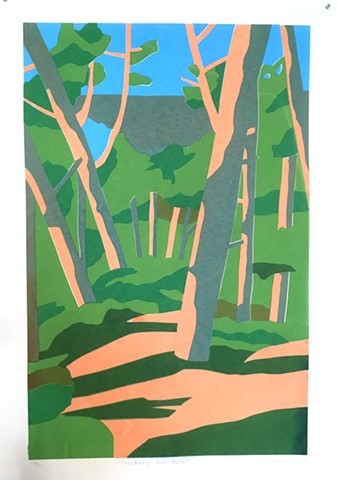Printmaking
Monterey Pine Forest
The Monterey Pines (Pinus radiata) of the Del Monte Forest form a corridor lining Highways 1 and 68 on the Monterey Peninsula. On clear days, gaps in the trees reveal sweeping ocean views. But on most summer days, the forest is shrouded in mist. John Steinbeck describes such a day in Tortilla Flat when “the fog hung like limp gauze among the black pines that guard the landward limits on Monterey”. This persistent fog is an essential source of moisture for the Monterey pines in the summer months when there is no rain. The minimum relative humidity in Monterey in July is around 60 or 70%, and fog is present about one third of the days each year. While the Monterey Pine is the most planted conifer due to its fast growth and versatile use in forestry, there are only five native populations and the Del Monte Forest is one of these. The others are Año Nuevo, Cambria, and on two islands offshore of Baja.
During parts of the Pleistocene, Monterey pines (and their close relatives the Bishop and Knobcone pines) were more widely distributed along the California coast, before their range contracted to the “relict” populations we have today. Populations of Monterey pines expanded and contracted with the cycles of glacial and interglacial periods (warming and cooling) over the past two million years. Glacial periods, or “ice-ages” typically lasted about 90,000 years, while the warm interglacial periods lasted about 10,000 years. Monterey pines thrived and expanded their range when the climate was a bit cooler than today and there was more distinct seasonality with plenty of rain in the winter.
